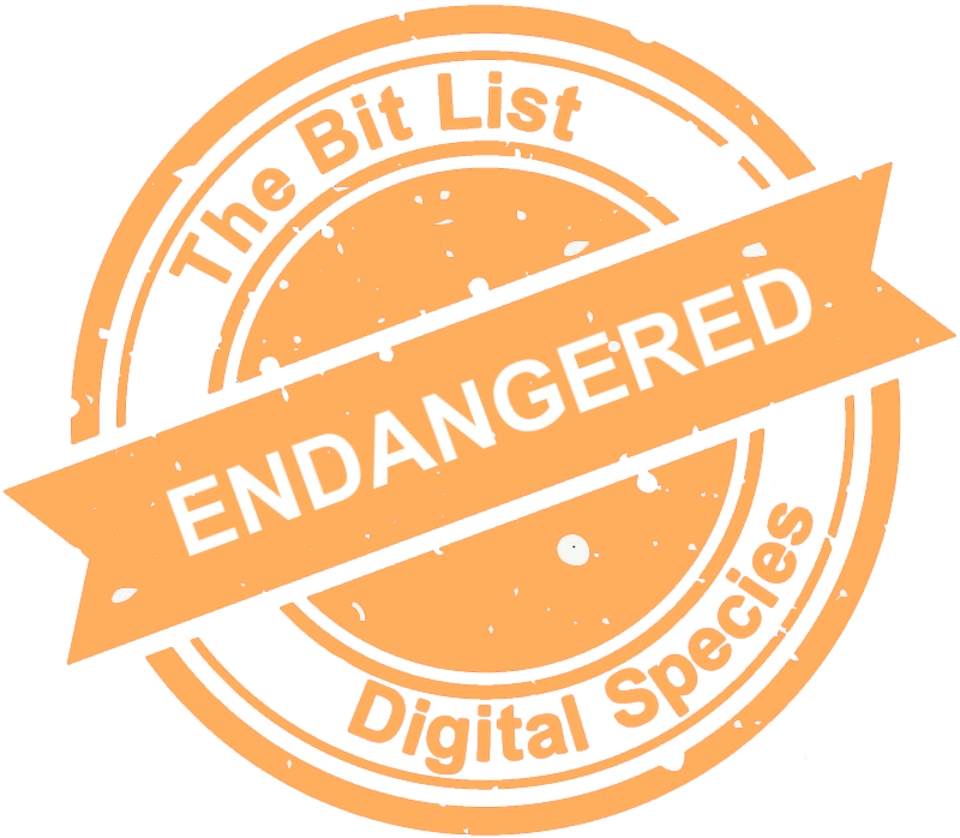Legacy Video Files
|
|
 |
|
|
Video files in any format containing moving pictures and sound recordings, particularly those that are proprietary, contain or utilize encrypted Digital Rights Management (DRM) or carrier bound. |
||
|
Digital Species: Sound and Vision, Formats |
Trend in 2023:
|
Consensus Decision |
|
Added to List: 2019 |
Trend in 2024:
|
Previously: Endangered |
|
Imminence of Action Action is recommended within three years, detailed assessment within one year. |
Significance of Loss The loss of tools, data or services within this group would impact on people and sectors around the world. |
Effort to Preserve | Inevitability It would require a major effort to prevent losses in this group, such as the development of new preservation tools or techniques. |
|
Examples STARDIVA; AVI; MOV; MKV; MP3; MP4; on DVD or other carriers. |
||
|
‘Critically Endangered’ in the Presence of Aggravating Conditions Lack of replication; encryption; digital rights management; Uncertainty over IPR or the presence of orphaned works; proliferation of file formats; weak or non-existent technical documentation; lack of preservation capability or commitment; poorly managed or digitization processes or QA; reliance on encoding/decoding software; Uncertainty over IPR or the presence of orphaned works. |
||
|
‘Vulnerable’ in the Presence of Good Practice Effective replication; normalization of file formats; strong technical documentation; preservation pathway; good descriptive cataloguing; clear licensing to enable preservation; trusted repository. |
||
|
2023 Review This entry was added in 2019 under ‘Video files’ to emphasize the issues of video preservation that pertain to offline recording, whether from broadcast, film industry, institutional and private collections. The 2019 Jury noted the connections between this entry and others relating to social media but argued for a standalone to emphasize the range of issues tied to numerous formats and standards. The 2021 Jury discussed the need for further rescoping, arguing that the entry was too broad to be useful without specifying at-risk types or formats. For this reason, its scope was narrowed to legacy videos that are proprietary, encrypted or carrier-bound. The classification remained Endangered with a 2021 trend towards greater risk given the growing content of at-risk legacy video files but a limited mandate. The 2022 Taskforce noted no change to the trend (they agreed these risks remain on the same basis as before). The 2023 Council agreed with the Endangered with the overall risks remaining on the same basis as before (‘No change’ to trend). Additionally, they agreed that a submitted Bit List nomination for the NSV-based STARDIVA storage format would provide a good example of a video file format especially at risk due to aggravating conditions rather than a separate stand-alone entry. |
||
|
2024 Interim Review These risks remain on the same basis as before, with no significant trend towards even greater or reduced risk (‘No change’ to trend). Council members in the Formats species groups recommended further rescoping of overlaps, in particular to differences between formats and physical carries mentioned, which have different risks and issues. The listing of DVDs or other carriers, for example, may be better suited under the Portable Media species. |
||
|
Additional Comments There are simply too many formats and too many standards, but the FFMPEG project and its related tools have significantly mitigated the technical risk to most video files. This enables a practitioner to transform the vast majority of file formats to safer preservation formats while retaining significant properties. However, technical risk is only one of the factors. There needs to be institutional engagement with audio-visual data as a priority. The issue then becomes one of identifying the organizations responsible and, constrained by the cost to store video data, making effective selection decisions. Case Studies or Examples:
See also:
|
||





































































































































